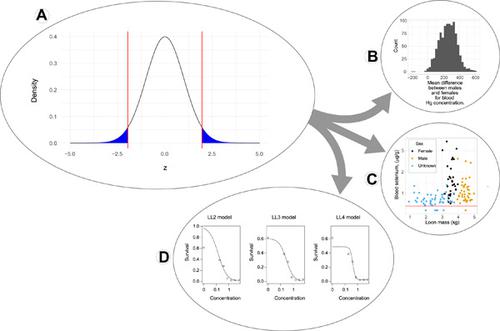当前位置:
X-MOL 学术
›
Environ. Toxicol. Chem.
›
论文详情
Our official English website, www.x-mol.net, welcomes your
feedback! (Note: you will need to create a separate account there.)
Moving beyond p<0.05 in ecotoxicology: A guide for practitioners.
Environmental Toxicology and Chemistry ( IF 3.6 ) Pub Date : 2020-06-15 , DOI: 10.1002/etc.4800 Richard A Erickson 1 , Barnett A Rattner 2
Environmental Toxicology and Chemistry ( IF 3.6 ) Pub Date : 2020-06-15 , DOI: 10.1002/etc.4800 Richard A Erickson 1 , Barnett A Rattner 2
Affiliation

|
Statistical inferences play a critical role in ecotoxicology. Historically, null hypothesis significance testing (NHST) has been the dominant method for inference in ecotoxicology. As a brief and informal definition of NHST, researchers compare (or “test”) an experimental treatment or observation against a hypothesis of no relationship (the “null hypothesis”) using the collected data to see if the observed values are statistically “significant” given predefined error rates. The resulting probability of observing a value equal to or greater than the observed value assuming the null hypothesis is true is the p value. Criticisms of NHST have existed for almost a century and have recently grown to the point where statisticians, including the American Statistical Association (ASA), have felt the need to clarify the role of NHST and p values beyond their current common use. These limitations also exist in ecotoxicology. For example, a review of the 2010 Environmental Toxicology & Chemistry (ET&C) volume that found many authors did not correctly report p values. We repeated this review looking at the 2019 volume of ET&C. Incorrect reporting of p values still occurred almost a decade later. Problems with NHST and p values highlight the need for statistical inferences besides NHST, something long known in ecotoxicology and the broader scientific and statistical communities. Furthermore, concerns such as these led the executive director of the ASA to recommend against use of “statistical significance” in 2019. In light of these criticisms, ecotoxicologists require alternative methods. We describe some alternative methods including confidence intervals, regression analysis, dose–response curves, Bayes factors, survival analysis, and model selection. Lastly, we provide insights for what ecotoxicology might look like in a post–p value world. Environ Toxicol Chem 2020;39:1657–1669. Published 2020. This article is a U.S. Government work and is in the public domain in the USA.
中文翻译:

生态毒理学超越p <0.05:从业人员指南。
统计推断在生态毒理学中起着至关重要的作用。从历史上看,零假设重要性检验(NHST)一直是生态毒理学推论的主要方法。作为NHST的简要和非正式定义,研究人员使用收集到的数据将实验处理或观察结果与无关联假设(“零假设”)进行比较(或“测试”),以观察观察值是否在统计上“显着”给定预定义的错误率。假设原假设为真,观察值等于或大于观察值的结果概率为p值。对NHST的批评已经存在了近一个世纪,并且最近发展到了这样的地步,包括美国统计协会(ASA)在内的统计学家认为,有必要澄清NHST和p值的作用,以超越其当前的普遍用途。这些限制在生态毒理学中也存在。例如,对2010年环境毒理学和化学(ET&C)卷的评论发现,许多作者没有正确报告p值。我们重复了这篇评论,着眼于ET&C的2019年销量。p值的错误报告仍然发生将近十年。NHST和p的问题值强调了除了NHST(在生态毒理学和更广泛的科学和统计社区中众所周知的东西)以外的统计推断的必要性。此外,由于这些担忧,导致ASA执行董事在2019年建议不要使用“统计意义”。鉴于这些批评,生态毒理学家需要其他方法。我们描述了一些替代方法,包括置信区间,回归分析,剂量反应曲线,贝叶斯因子,生存分析和模型选择。最后,我们提供了有关在p后价值世界中生态毒理学看起来如何的见解。Environ Toxicol Chem 2020; 39:1657-1669。出版于2020年。本文是美国政府的工作,在美国属于公共领域。
更新日期:2020-06-15
中文翻译:

生态毒理学超越p <0.05:从业人员指南。
统计推断在生态毒理学中起着至关重要的作用。从历史上看,零假设重要性检验(NHST)一直是生态毒理学推论的主要方法。作为NHST的简要和非正式定义,研究人员使用收集到的数据将实验处理或观察结果与无关联假设(“零假设”)进行比较(或“测试”),以观察观察值是否在统计上“显着”给定预定义的错误率。假设原假设为真,观察值等于或大于观察值的结果概率为p值。对NHST的批评已经存在了近一个世纪,并且最近发展到了这样的地步,包括美国统计协会(ASA)在内的统计学家认为,有必要澄清NHST和p值的作用,以超越其当前的普遍用途。这些限制在生态毒理学中也存在。例如,对2010年环境毒理学和化学(ET&C)卷的评论发现,许多作者没有正确报告p值。我们重复了这篇评论,着眼于ET&C的2019年销量。p值的错误报告仍然发生将近十年。NHST和p的问题值强调了除了NHST(在生态毒理学和更广泛的科学和统计社区中众所周知的东西)以外的统计推断的必要性。此外,由于这些担忧,导致ASA执行董事在2019年建议不要使用“统计意义”。鉴于这些批评,生态毒理学家需要其他方法。我们描述了一些替代方法,包括置信区间,回归分析,剂量反应曲线,贝叶斯因子,生存分析和模型选择。最后,我们提供了有关在p后价值世界中生态毒理学看起来如何的见解。Environ Toxicol Chem 2020; 39:1657-1669。出版于2020年。本文是美国政府的工作,在美国属于公共领域。











































 京公网安备 11010802027423号
京公网安备 11010802027423号